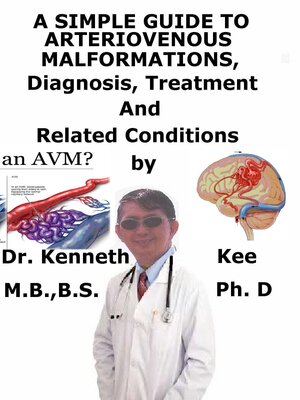A Simple Guide to Arteriovenous Malformations, Diagnosis, Treatment and Related Conditions
ebook
By Kenneth Kee

Sign up to save your library
With an OverDrive account, you can save your favorite libraries for at-a-glance information about availability. Find out more about OverDrive accounts.
Find this title in Libby, the library reading app by OverDrive.



Search for a digital library with this title
Title found at these libraries:
| Library Name | Distance |
|---|---|
| Loading... |
This book describes Arteriovenous Malformations, Diagnosis and Treatment and Related Diseases
I was watching an episode of Transplant, a Canadian TV series in which there was a female patient who suffered from back pain and became addicted to morphine derivative medicines.
She suddenly started bleeding in the skull and developed seizures.
The usual blood tests and CT and MRI imaging could not detect the cause.
Magnetic resonance angiography (MRA) and Super-selective angiography was able to detect AVMs on the back of the spine which caused her back pain and in the brain causing her to bleed in the brain and had seizures.
With a proper diagnosis, the medical team in the hospital was thus able to treat her.
Arteriovenous malformations (AVMs) are formed when a group of blood vessels in the body develops incorrectly.
In these malformations, arteries and veins are abnormally twisted and form direct connections, bypassing normal tissues such as capillaries.
This normally happens during development before birth or shortly after.
Most patients with AVMs do not have early signs and symptoms.
Instead, the disorder is detected when doctors are treating another unrelated health disorder.
Occasionally the rupture of one blood vessel in an AVM will capture medical attention.
Occasionally AVMs are only discovered after death during an autopsy.
No one knows the reason that AVMs form.
Some doctors think that the cause of developing AVMs could be genetic.
AVMs can form anywhere in the body.
Those that develop in the brain or close to the spinal cord, termed neurological AVMs, are most prone to have long-term effects.
The biggest problem linked to AVMs is that they will cause uncontrolled bleeding or hemorrhage.
Fewer than 4 % of AVMs will hemorrhage but those that do can produce severe, even fatal, effects.
Death as a direct effect of an AVM happens in about 1 % of people with AVMs.
Occasionally AVMs can decrease the quantity of oxygen reaching the brain and spinal cord (sometimes termed a steal effect as if the blood was being stolen from where it should flow).
AVMs can occasionally apply pressure on neighboring tissues.
The steal effect can also happen elsewhere in the body such as the hands or feet but may not be as obvious.
Frequent symptoms of brain AVMs are:
Bleeding in the skull, most often a sub-arachnoid hemorrhage
Seizures
Headaches
Focal neurological deficits, such as weakness, numbness, tingling to one part or side of the body
Frequent symptoms for AVMs evident in the organs, chest, or abdomen are:
Abdominal pain
Back pain
Chest pain
Irregular sounds in the affected blood vessels
The final diagnosis of AVM is normally made based on imaging tests that demonstrate areas of blood flow.
MRI is essential for the initial diagnosis of AVM
Magnetic resonance angiogram (MRA) produces images of the blood vessels
The treatment of an AVM is directed on treating the symptoms and improving the quality of life of the patient.
There are no medicines that have been shown to cure an AVM.
Medicines are given to relieve pain and stop seizures.
There are three invasive treatment methods:
Conventional surgery is done to totally remove a small or moderate AVM
Radiosurgery treats small unruptured AVM
Embolization and sclerotherapy are the most frequent treatments to treat AVMs
Materials such as medical glue, metal coils or even plugs are placed into the center of the AVM through a catheter to block blood flow and kill the AVM
TABLE OF CONTENT
Introduction







